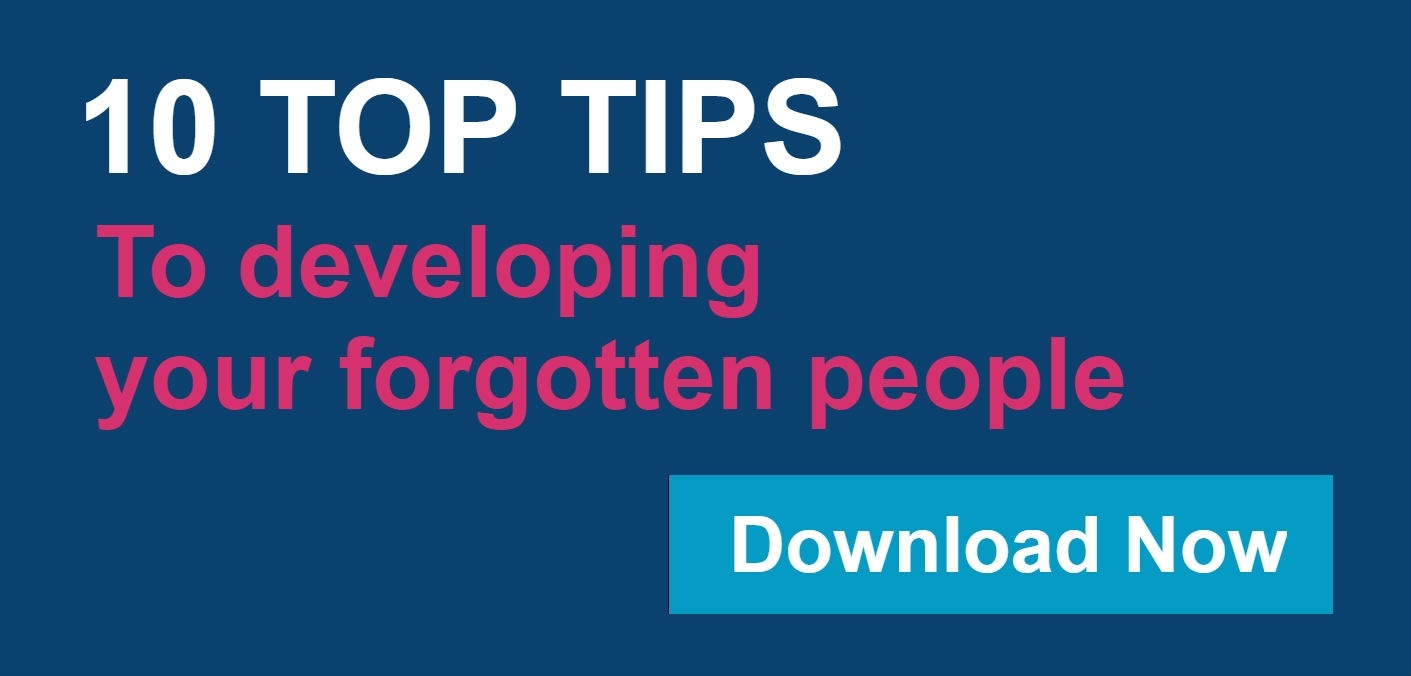 How do organisations develop their huge, often diverse, population of middle to senior managers? Remembering these 'forgotten people' can be the tipping-point to take an organisation on to greater success.
How do organisations develop their huge, often diverse, population of middle to senior managers? Remembering these 'forgotten people' can be the tipping-point to take an organisation on to greater success.
In our experience, organisations are very accustomed to creating development interventions for three particular groups; Graduate entrants, High-potential talent, and Board-level executives. Whilst graduates may number in their hundreds, creating an on-boarding development programme is relatively straightforward because there will generic components, and a standard process of work-rotations. High-potential talent are often offered a programme which incorporates projects and stretch assignments. Board-level programmes may be more complex and diverse, but the number of people involved is far smaller. The development programmes for these three groups are therefore relatively easy to create and administer, and the return on investment is, on the surface, also easy to measure. How many graduates stay with the organisation longer than two years? How many of your HiPo’s move into senior roles? What is the change in share price after the Board development has finished? Perhaps not the best questions to ask, but certainly easy ones to answer.
Yet within every large organisation there lies a huge population of middle to senior managers. Often these employees are managing others, but not stepping up and leading. Their size and diversity means that creation of effective development for them is a bigger challenge. They are often uncomplainingly producing solid but not stunning results. As they are deemed to be “doing enough” it is assumed that they don’t need development. For these reasons they are often overlooked and forgotten.
Here at Cranfield we are now very experienced at creating bespoke development solutions for 'The Forgotten People'. It isn’t an easy process, and the clients who have come to us wanting to develop this group of people have had to work very hard with us, but the results are well worth it. The large size of this cohort, plus the already high level of loyalty and motivation that often exists in the people who ‘beaver away in the background’, means that a client can end up with a huge ground-swell of newly-engaged people with enhanced effectiveness.
One solution that sticks in my mind was for a global financial organisation who were suffering from the media backlash. As an organisation they were in no danger of being forgotten; but they were being remembered for the wrong reasons. They knew they had to develop the leadership capability of their Forgotten People. They were also insightful enough to recognise that their Forgotten People were not a homogenous group. Before approaching us for help they had identified three distinct groups:
- Those who were new to a leadership role
- Those who had been in role for a while but not stepped up to leadership
- Those who were in the role, performing well as leaders, but had had no development for a long time and therefore their leadership practice needed a refresh.
So this was a large group of people, over 400 managers, all coming from different functions and departments, with a range of starting points, and a raft of diverse ambitions. How does one create a development programme that caters for such diversity, is consistently impactful, yet cost-effective?
There were several things that enabled us, in collaboration with the client to do just that.
A clear description of the needs, and the reasons for those needs
The client didn’t come to us with a pre-written shopping list; they knew it was important to allow us to explore the individual’s requirements. They allowed us to dig into the context, to ask a wide range of employees totally open questions, to bring our expertise to the table.
Acceptance that what the organisation wants isn’t necessarily what the employee wants
We helped the client make a clear distinction between the needs of the organisation and the needs of the individual, and be comfortable with the difference between the two. Within each module of development the individuals were encouraged to articulate what they wanted from the module, and then work in buddy pairs and coaching trios to reflect upon what they were taking away from the module.
Collaborative design
We set up a joint design group to design the programme. Each of the client divisions were represented on the design group. In this way, the design was signed off by every division which thereby created ownership.
Diversity of cohorts
The client was as committed to diversity of thought as ourselves, so the design group decided on the mix of each cohort, ensuring there was a mix of levels in terms of seniority and experience, and a mix of divisions.
Design of the process as well as the content
The process included fundamental approaches to development which underpinned the content.
- Clarification of the impact required from the programme and sets of measures to ensure that behavioural change had occurred
- Use of professional role-players who worked with scenarios participants had created themselves, to enable participants to put new knowledge into action by working on real-time conversations
- A programme flow which took an inside-out approach. It began with participants gaining a better understanding of themselves, and ended with “How to effect change”. Components in between ensured that when the “Change” piece was reached, all participants were highly sensitised to the tenet that “It is how you show up that will make the difference”
- Every cohort was encouraged to flex and adapt the content of their modules to suit their own learning needs. In this way, every cohort created their own learning journey
- At each and every stage, both macro and micro, participants knew explicitly “What we will do”, “Why we will do it”, and “This is what we will get out of it”
By working alongside us, and being open to our challenges, the client ended up with a flexible but cohesive development solution. This in turn led to 400 diverse managers realising that their organisation valued them enough to put time, energy and resources into helping them become the type of leaders who would be remembered for the right reasons.




